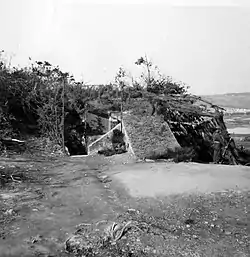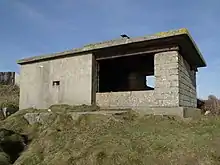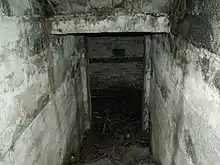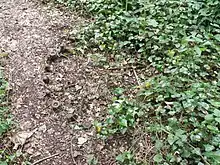Par Coastal Gun Battery
The Par Coastal Gun Battery was a coastal gun battery constructed in the summer of 1940 when Britain was facing the threat of invasion from Nazi Germany. It is situated on the old Par Consols Mine site on the high ground overlooking Par Docks.[1][2][3]
| Par Coastal Gun Battery | |
|---|---|
| Par, Cornwall, United Kingdom Near St Austell in United Kingdom | |
 Gun No.2 | |
 Par Coastal Gun Battery | |
| Coordinates | 50°20′41.76″N 4°42′35.36″W |
| Site information | |
| Condition | Ruined |
Establishment of the Battery
| Date | State of the Battery |
|---|---|
| 24 June 1940 | Defence consisted of two 4 inch guns mounted on lorries by the Royal Navy and called ‘The Cornish Lorry Battery’. |
| 11 July 1940 | Two 3-pounder guns were sited at the docks entrance to protect the small wooden vessel boat building being undertaken at Par. |
| 28 July 1940 | It was decided by Southern Command to build a coastal gun battery at Par and the site of the old Par Consols Mine was chosen. 393 Coast Battery of the 70th Medium regiment, Royal Artillery, was formed that day with 3 officers and 91 other ranks. |
| 29 July 1940 | 393 Coast Battery arrived in Par by train and were found billets by the local police. A temporary Battery Office was established in the Par Inn. |
| 3 August 1940 | Two 4 inch breech loading Mark PIIx guns arrived at Par Station. |
| 17 August 1940 | Both guns were mounted. |
| 23 August 1940 | Both guns were pulled back, their sights were tested, and 2 rounds of practice shot fired from each gun. |
| 25 August 1940 | The Luftwaffe tried bombing the site but missed, hitting fields between Spit Beach and the clay dries.[4] |
| 5 September 1940 | The Lorry Battery was withdrawn from Par. |
| September 1940 | Four accommodation huts were built in an adjoining field on Mount Farm. The neighbouring house, now called Reynard's Rest, was used as the Officer's Mess. |
Role of the Battery
The Battery's primary role was to deny the port & beaches to the enemy by engaging ships seawards. The secondary roles were to neutralise the beaches at Polkerris, Par Sands & Spit Beach, and to complete immobilisation of harbour installations if the Local Naval Officer fails to do so. Priority being:[5]
i. Pier Head
ii. Crane at Inner Dock
iii. Crane at North Quay
iv. Footbridge at Inner Dock
The battery would engage vessels in the following order:
i. Armoured Fighting Vehicle-carrying transports
iii. Warships
CASLs
Two Coastal Artillery Search Light batteries were built at the water's edge on the west side of the harbour entrance. Both were of the same design. Their purpose was to illuminate the target for the guns at night. No.1 CASL was completed on 17 March 1941. Its light could be worked by hand or remote control. No.2 CASL was completed on 30 May 1941. It was hand controlled only.
Only one of the CASLs remains. The other was undermined by coastal erosion and its steel girders supporting the roof collapsed. There are a few remnants on the shoreline. To preserve the other a concrete block wall was built to support the roof girders changing the look of the battery from an open faced building with large steel shutters to a building with smaller embrasures.
The CASLs were powered by an engine house sited just behind the Batteries but this was demolished by the china clay company in the early 2000s.
Life of the Battery


The battery never fired a shot in anger. There were a number of practice firings both by day and by night. The Par Home Guard defended the perimeter of the battery.[6][7] The nearest the battery came to being hit by German bombs was at 0500hrs on 13 April 1941 when the Harbour Master's house received a direct hit killing one soldier from the DCLI on coastal defence duties. The Paddington-Penzance railway line was also damaged.[8] In April & May 1942 the 4 inch guns were dismounted and replaced by two 138mm GF guns from the French naval ship 'Paris' which had been seized on 3 July 1940 in Plymouth and then used as a barracks ship by the Polish Navy.[9] In 1943 the site was developed to improve the accommodation and facilities for the men serving on the battery.[5] The top part of the site was used by the Americans in 1944 and then after D-Day it became German Prisoner of War Camp 674, Consols, Par. The guns were finally dismounted in June 1945.[10]

Remains of the Battery
Five buildings remain on the site.[11] The War Shelter for No 1 gun, the Magazine for No 1 gun, the War Shelter for No 2 gun, the Magazine for No 2 gun and the Shell Store (where the shells were stored as opposed to the Cordite charges which were kept in the underground magazines). It is also possible to finds the gun mounting bolts under the vegetation. The top part of the battery was developed into a residential site, today called The Mount. One CASL remains by the water's edge at Spit Beach.
References
- The National Archives - WO 166-1855 393 Coast Battery August 1940
- "Heritage Gateway - Results". www.heritagegateway.org.uk. Retrieved 2020-11-01.
- "No Small Stir: The Bodmin Stop Line Part 7 - Fowey Estuary & The Neighbouring Beaches". YouTube.
- M Rowe & Rabey, Phyllis & Ivan (1987). When Bombs Fell. p. 5. ISBN 978-0950023557.
- The National Archives - WO 192-152 Par Battery Fort Record Book 1940-45
- Reynolds, Derek G. Par Excellence.
- Cornwall Constabulary War Diary entry for 13th April 1941 – original document held at Kresen Kernow, Redruth.
- "BBC - WW2 People's War - "When Bombs Fell" - The air-raids on Cornwall during WW2 : Part 3 - 1941 January to April". www.bbc.co.uk. Retrieved 2020-11-03.
- "French battleship Paris", Wikipedia, 2020-10-13, retrieved 2020-11-03
- "PoW Camp 674 Consols Mine". Repatriated Landscape. 2020-05-12. Retrieved 2020-11-03.
- Cornwall Historic Environment Record Entry No 75518